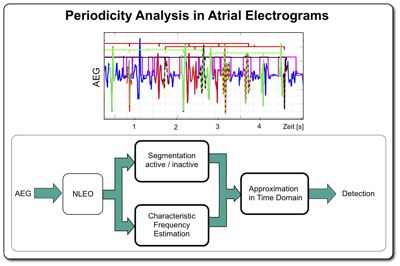Time-Frequency-Analysis and Blind Source Separation of Local Atrial Electrograms
- chair:Medical measurement technology / Digital signal processing
- type:Diplomarbeit
- tutor:
- person in charge:
-
Atrial fibrillation is the most common type of cardiac arrhythmia, with a prevalence of over 0.5 percent in the total population. It is an age-related arrhythmia and often leads to severe complications such as stroke or other embolic incidents. The current treatment options of atrial fibrillation include medicinal treatment as well as surgical and electrical approaches: Drugs are used for anticoagulation (to prevent blood clots) as well as for rhythm-controll and rate-control. Controlled electrical shock therapies (cardioversion) are applied in acute cases of atrial fibrillation and are known to instantly stop this chaotic atrial excitation propagation. Recently, catheter ablation has become an increasingly important strategy for maintaining sinus rhythm. In the procedure, a catheter is inserted via the femoral vein into the right atrium and (through the septum) into the left atrium. Radiofrequency energy is applied on the endocardium in order to create scars that break the pathologic excitation propagation.
Areas of complex fractionated atrial activity are the focus of electrophysiologists and are targeted in the course of catheter ablation therapy. The underlying mechanisms of complex fractionated atrial electrograms (CFAEs), however, are not entirely understood. For complex cardiac signals, there are few methods to analyze them and extract information for therapy planning. It is the current aim of research to be able to extract and quantify characteristic information of complex cardiac signals in order to help the electrophysiologist to understand the pathologic behavior of the atrium and the source of malfunction.
In the scope of this thesis, an algorithm for detection of periodic elements within a complex cardiac signal was developed. It is based on the estimation of characteristic frequencies contained within the signal. For this purpose, it makes use of the harmonic frequencies contained in every repeatedly occurring signal. The algorithm proved to be a valuable filter to analyze atrial flutter signals in order to determine the origin of the focus of the excitation within the heart. Furthermore, it may provide valuable information for the physician, as to what degree complex cardiac signals are composed of reoccurring cardiac events. To date, cardiac signals are often characterized by its most dominant frequency. This work supports the idea of multiple characteristic frequencies that are contained within a cardiac signal. Through the calculation of its time representation, it may provide new insights into the significance of characteristic frequencies.
Many atrial signals are tainted with electrical activity originating from the ventricles. Physicians call this effect, that can have a significantly higher amplitude than the atrial signals, the ventricular far field. In this thesis, a method to remove these superimposed signal parts was described. It is based on the Principal Component Analysis (PCA), a method of Blind Source Separation. The method has proven to remove the far fields to a great extent, resulting in correlation rates of over 95 percent to the clean atrial signal.

